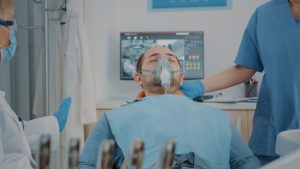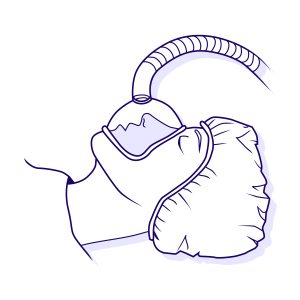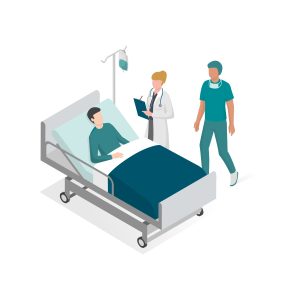General Anesthesia: The Most Potent Sedation Method
General sedation dentistry techniques, while incredibly helpful, may not always be enough. When it comes to certain dental procedures that involve extensive treatment, significant discomfort, or dental anxiety, general anesthesia can provide a safe and effective solution. West Sayville sedation dentist, Dr. Richard Sigismondi understands the importance of patient comfort and offers the option of general anesthesia for those who require a deep level of sedation during their dental treatment.
What is General Anesthesia?
General anesthesia is a specialized sedation technique that induces a state of deep sleep, rendering the patient completely unconscious and unaware during the dental procedure. Unlike other forms of sedation, such as nitrous oxide or oral sedation, general anesthesia is administered intravenously by a qualified anesthesiologist or dental anesthetist. It may also involve the use of inhaled gasses and other medications.
The Benefits of General Anesthesia
There are many benefits to general anesthesia, some of which include the following:
- Profound Relaxation: General anesthesia ensures a profound level of relaxation, eliminating any anxiety or fear associated with dental procedures. Patients are completely unaware of the treatment being performed, allowing the dental team to focus on providing optimal care without causing distress.
- Pain-Free Experience: With general anesthesia, patients do not experience any pain or discomfort during the dental procedure. This is particularly beneficial for complex or invasive treatments that may otherwise cause significant discomfort.
- Time Efficiency: General anesthesia allows the dental team to work efficiently and effectively since the patient remains still and unresponsive throughout the procedure. This can result in shorter treatment times, minimizing the visits required for extensive dental work.
- Suitable for All Ages: General anesthesia can be used for patients of all ages, including young children or individuals with special needs who may struggle with cooperation during dental treatments.
General Anesthesia vs. Other Sedation Dentistry Options
It’s important to differentiate between general anesthesia and other sedation options commonly used in dentistry. While nitrous oxide (laughing gas) and oral sedatives can provide varying levels of relaxation and pain control, general anesthesia offers the deepest level of sedation.
General anesthesia involves a complete loss of consciousness, while other sedation methods allow patients to remain conscious or semiconscious during the procedure. The appropriate sedation option will depend on the complexity of the dental treatment, the patient’s medical history, and their level of dental anxiety.
How to Prepare for General Anesthesia
Preparing for anesthesia is essential to ensure a safe and smooth dental procedure. Here are some guidelines to follow:
Consultation and Evaluation
Before the procedure, you will have a consultation with Dr. Sigismondi and our dental team. We will review your medical history, and discuss any pre-existing conditions, medications, and allergies. It is crucial to provide accurate information to ensure your safety during general anesthesia.
Fasting Instructions
In most cases, you will be required to fast for a certain period before the procedure. This includes avoiding food and liquids, including water, for a specified amount of time. Fasting helps minimize the risk of complications related to anesthesia and ensures your safety during the procedure.
Medication Instructions
If you take regular medications, we’ll provide specific instructions on which medications to take or avoid before the procedure. It’s important to follow these instructions carefully to prevent any interactions or complications.
Transportation Arrangements
Since the effects of general anesthesia can impair your coordination and judgment, it is crucial to arrange transportation to and from our dental practice. We recommend having a responsible adult accompany you for the procedure and assist you afterward.
Clothing and Personal Items
Wear comfortable clothing on the day of the procedure. Avoid wearing jewelry, contact lenses, or any accessories that may interfere with the anesthesia process. Bring only essential personal items with you to the appointment.
Recovery from General Anesthesia
After undergoing general anesthesia, it’s important to allow yourself enough time to recover. Here are some important aspects of the recovery process:
Post-Procedure Monitoring
Following the dental procedure, you will be closely monitored in a recovery area. Our experienced team will check your vital signs, such as heart rate, blood pressure, and oxygen levels, to ensure a safe recovery.
Rest and Observation
You may feel groggy, disoriented, or sleepy after waking up from anesthesia. It is important to rest and allow your body to recover. The dental team will provide a comfortable environment for you to rest and monitor your progress.
Follow-Up Instructions
Our dental team will provide detailed post-operative instructions, including information on oral care, diet, and any necessary follow-up appointments. It is crucial to follow these instructions diligently to support proper healing and minimize the risk of complications.
Assistance and Support
It is advisable to have someone accompany you after the procedure to provide assistance and support. This person can help with transportation, provide care at home, and ensure your well-being during the initial recovery period.
Frequently Asked Questions
Yes, general anesthesia is considered safe for dental procedures when administered by trained professionals in a controlled medical setting. Our dental practice follows strict safety protocols to ensure your well-being throughout the procedure.
While general anesthesia is generally safe, like any medical procedure, there are potential risks and side effects. These can include nausea, sore throat, dizziness, or allergic reactions. However, our experienced team will conduct a thorough preoperative evaluation to assess your suitability for general anesthesia and mitigate any risks.
The recovery time from general anesthesia varies for each individual. Most patients experience some grogginess and drowsiness immediately after the procedure, but these effects typically subside within a few hours. It is advised to have someone accompany you and assist with transportation after the procedure.
While general anesthesia is generally safe, it may not be suitable for everyone. Factors such as underlying medical conditions, medications, and age can affect its appropriateness. During your consultation, your sleep dentist will evaluate your medical history and determine if general anesthesia is the right option for you.





